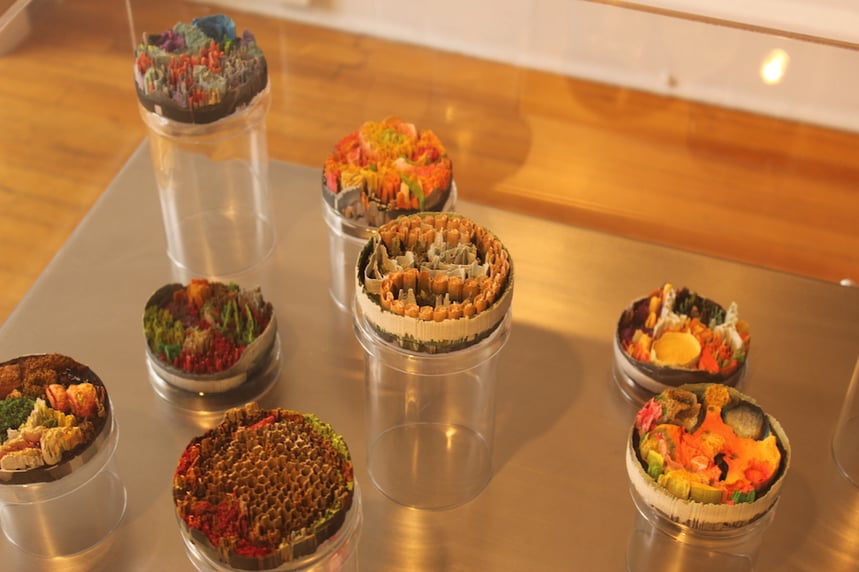
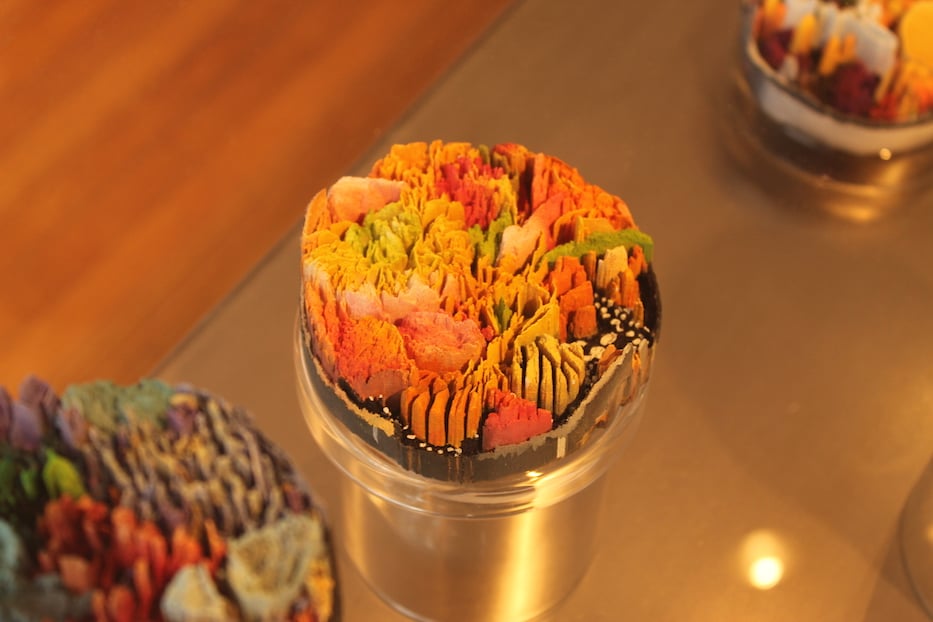
3D Printed petri dishes from After Eden, a solo show from bio artist Suzanne Anker running at the Ely Center of Contemporary Art through July 17. Al Larriva-Latt Photos.
A piece of sushi stoops in the corner of a petri dish, encircled by a ring of flower petals and a quartet of orange slices. Three maraschino cherries cohabit a petri dish with an empty honeycomb and a red ribbon. It’s as though 15 years after human extinction, all that’s been left behind are petri dishes of organic matter. They are juxtapositions, tongue-in-cheek.
They are also warnings: this could be soon us, our way of life, left as traces.
The pieces are works in After Eden, a solo show from bio artist Suzanne Anker running at the Ely Center of Contemporary Art (ECoCA) through July 17 of this year. It shares the second floor space with the exhibition Storytellers II (the first half, Storytellers, is on view at the Whitney Center’s Perspective Gallery until September 9, 2022), which showcases the work of nine artists.
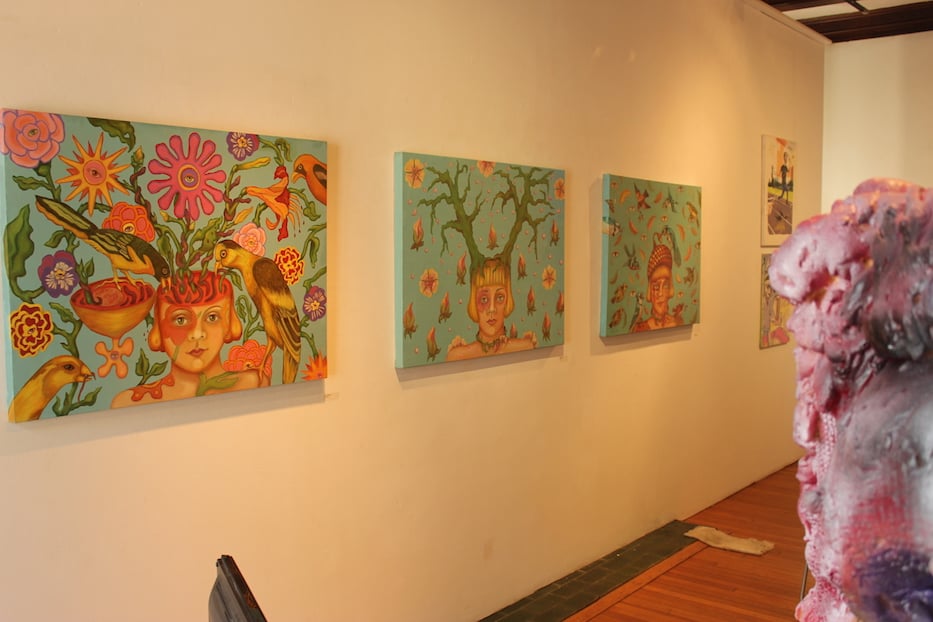
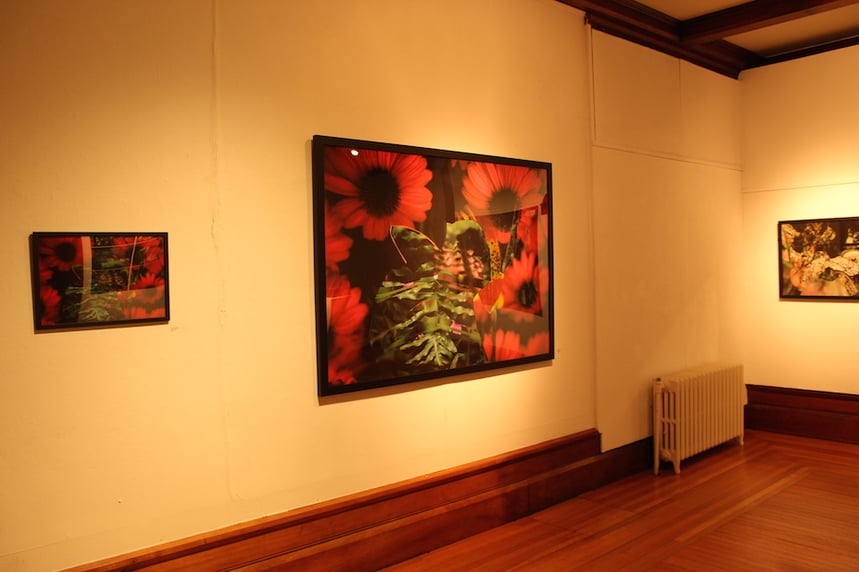
Top: A detail of Joan Wheeler's work.
They include Kwadwo Adae, Matthew Best, Jenn Cacciola, Tyler Cofrancesco, James Cofrancesco, Mary Dwyer, Anya Kotler, Melissa Sutherland Moss, and Joan Wheeler. While After Eden is a premonition of humanity’s earth-stricken future, Storytellers II engages the deep subjectivity of humanity’s present.
In After Eden, viewers get to engage with Anker’s work from the past 20 years, from 2000 to as recently as 2020. Anker is a pioneer in the field of Bio Art, which uses living matter as a media and scientific processes and biotechnology as tools. Her work contends with Charles Darwin’s metaphor of the “tangled bank,” which describes the interdependent web of living things in the natural world, all guided by an underlying set of laws.
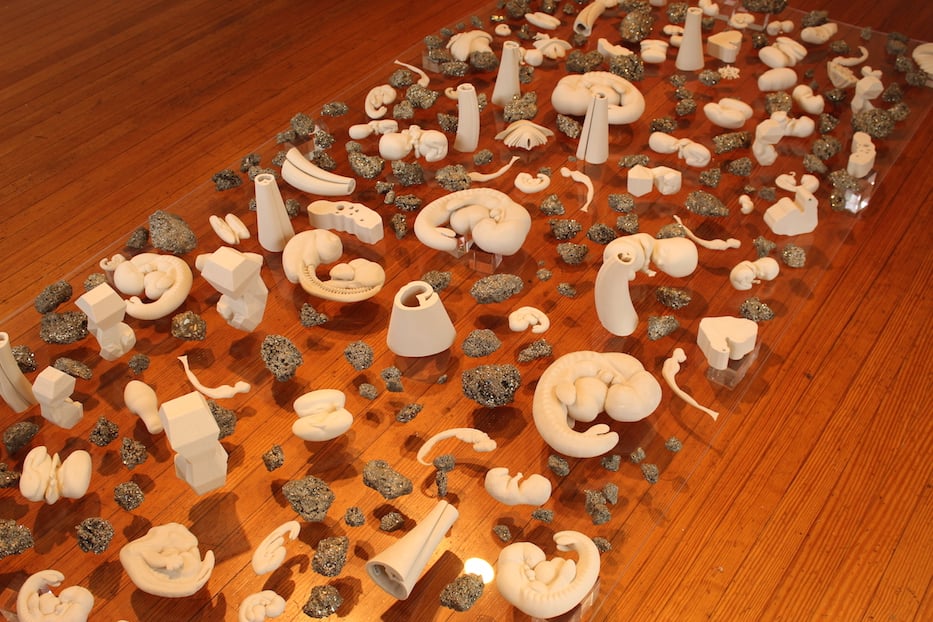
Anker is a pioneer in the field of Bio Art, which uses living matter as a media and scientific processes and biotechnology as tools.
The exhibition, on which she spoke during the International Festival of Arts & Ideas (watch that talk here) moves from the fundamental building blocks of life to the overflowing, abundant life. The downstairs Gallery Three is home to a plastic case of lowercase block letters, “a,” “c,” “g,” “t,” which reference the four bases of DNA. The additional “x” perhaps references the shape of the chromosome. Chromosomes comprise an organism’s genome, or complete genetic information.
In “Redux,” pairs of chromosomes repeat down the length of a rectangular silkscreen print. Sometimes there are 22 pairs—perhaps the genome of a eucalyptus tree or a Virginia opossum. Other times, there are just 18, perhaps an orange or a radish. In the center, the “x” shape of the chromosomes morph into the silhouettes of human figures, bending down to touch their toes or stretching outward, feet and arms stretched at acute angles, to take the form of an “x.” It’s a demonstration of humanity’s intuitive likeness to the basic units of life.
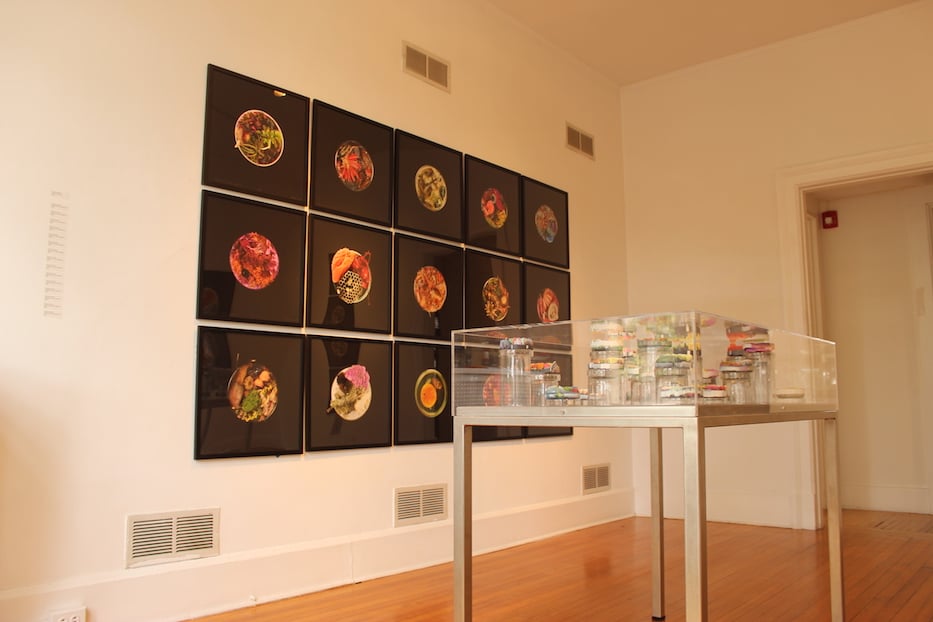
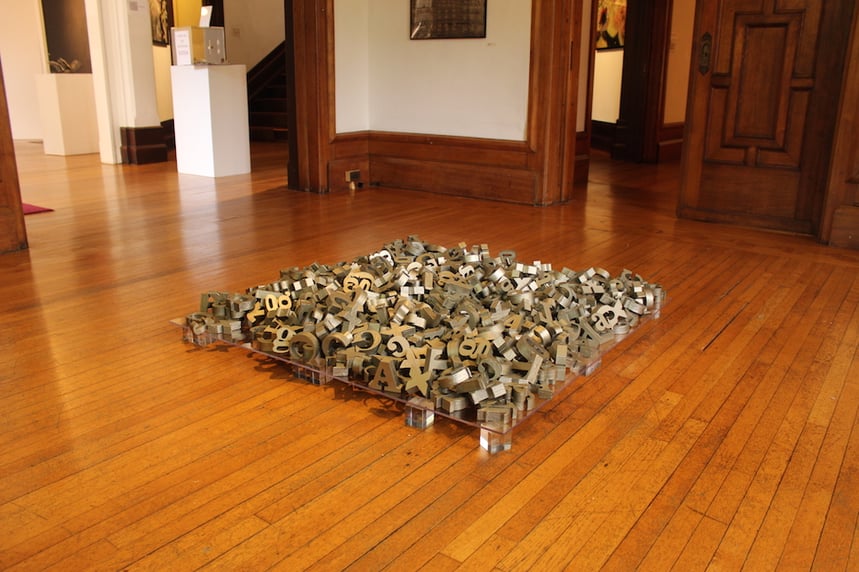
Top: Anker's "Remote Sensing." Bottom: Gallery Three.
On the upstairs floor, in Gallery One, comes the corollary: unfettered capitalism and environmental collapse. Anker's “Remote Sensing” consists of approximately a dozen “micro-landscapes,” elevated on pedestals of varying heights. They are otherworldly and captivating.
Anker’s process involves photographing matter in petri dishes, converting the color data into “3D protrusions,” and printing the protrusions in a 3D printer. It’s a technique the artist began using in the early 2000s, before 3D printing entered the mainstream.
In one micro-landscape, tall, tubular forms ring the edges of the petri dish, converging with a ribbons-like form that carves a path through the interior. Together, the two forms coalesce into an imposing wall. In the abysses formed by the spaces between the walls, there is no sign of life. They’re a visual metaphor for the toxic landscapes in Earth’s near future. .
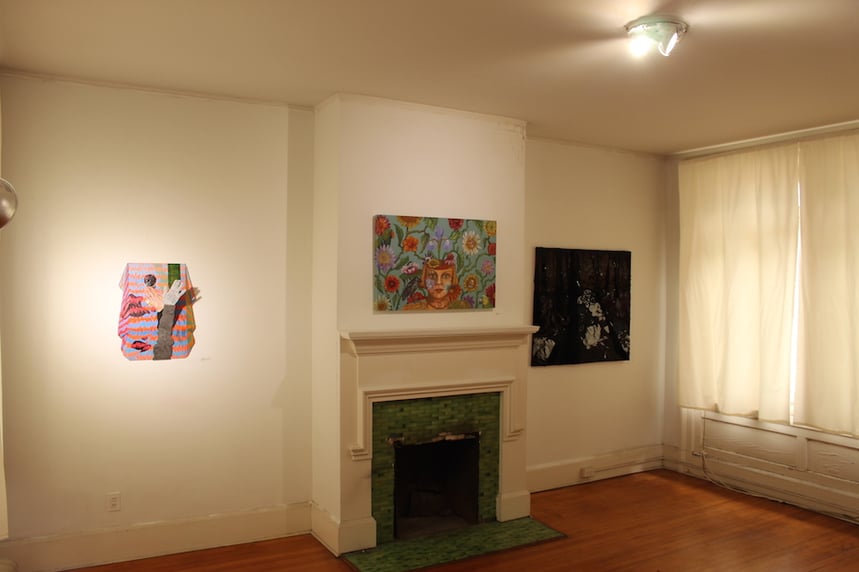
Works by Anya Kotler, Joan Wheeler, and Jenn Cacciola.
While desolation and dread run throughout Anker’s show (along with a technological craftiness and sense of wonder), its partner exhibition, Storytellers II, spins a different narrative. Also running through July 17, the character-driven Storytellers II tells of the human side of this contemporary age, bringing with it a deep subjectivity and empathy.
Tyler Cofresco’s "My Best Friend Skinner" meets the viewer’s eye as they climb the carpeted staircase to the second floor. The subject at its center wears a beard and a pompadour, high heels and a tiny backpack. Their gender presentation is a transgression, a triumphant revolt.
In the background is the dizzying uniformity of suburban life: tract two-story homes, wispy trees that resemble architectural rendering of vegetation. Pop culture interjects the landscape: at the subject’s feet, Mr. Potatohead-like figures raise their gloved hands and dance. It’s a story of contradictions and gaps of middle class life in the United States.
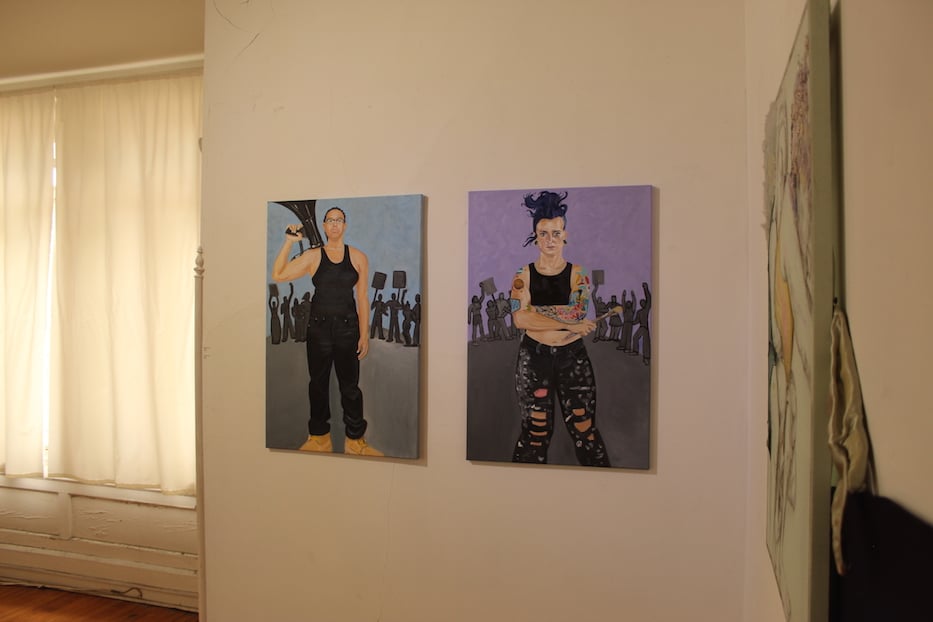
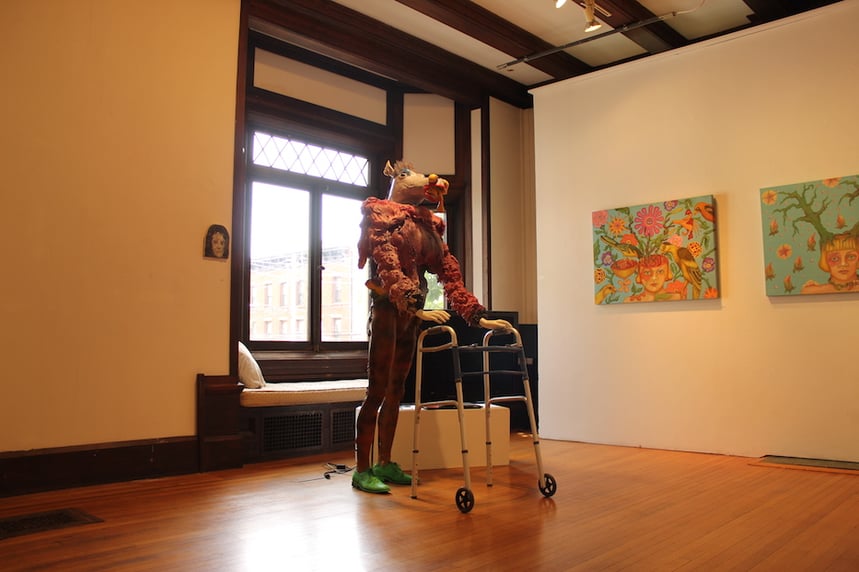
Top: Kwadwo Adae's Kerry and Sarah, both 2020. Bottom: James Cofrancesco, Yarraman, 2022.
The crisis of racism–parallel to that of climate change–enters the exhibition space in Kwadwo Adae’s full-body portraits of New Haveners who were prominent during the city’s 2020 Black Lives Matter protests and have been fierce voices in the fight against police brutality. Adae, an artist who runs a teaching studio on State Street, first painted the works for the 50th anniversary of May Day demonstrations in New Haven two years ago.
In “Kerry,” organizer Kerry Ellington hoists a megaphone over her shoulder. In a tight A-shirt, the outline of her breasts is visible and her muscles are bared. In the background, silhouetted protesters pump signs and fists into the air. It’s a Black, queer echo of the “We Can Do It” that centers Blackness, organizing and collective care rather than U.S. militarism.
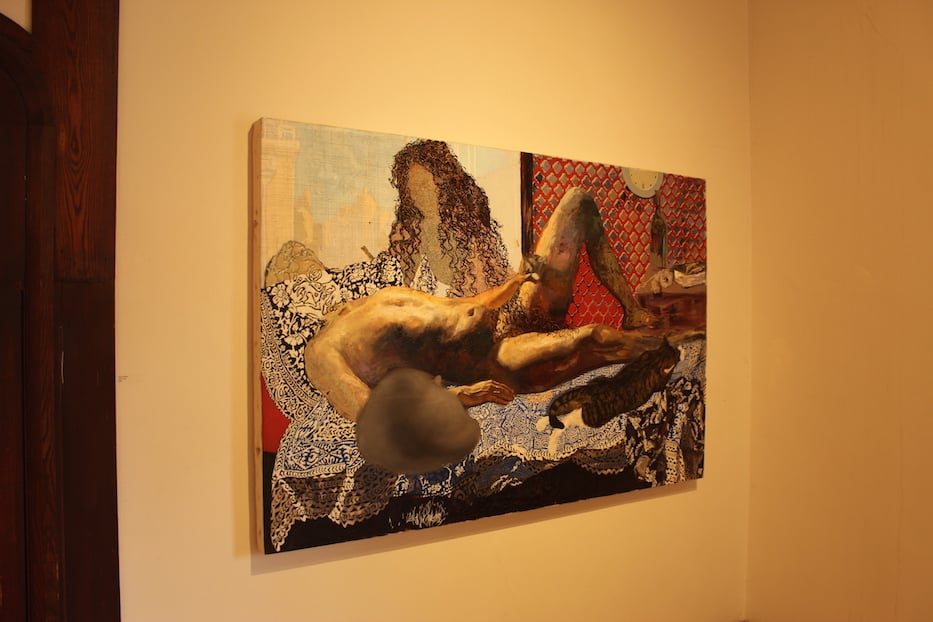
Anya Kotler, This Time, 2018.
The exhibition moves into a mental space in Anna Kotler’s “The poems,” a sculptural, tactile painting that takes carved panel as its canvas. Emerging from the panel is a feminine face, stricken with emotion. Its eye socket is a whirlpool of thickly applied oil paint, forming a wide, unfocused stare. To the right of the face is its mirror image, another feminine face, only, it is featureless.
Hair follicles wind around the two heads and taper into thick, cylindrical appendages. The appendages are fingers that wrap around the necks of both women and around a pencil, which protrudes from the canvas. The multiple selves depicted are caught in a self-woven web of anguish, where creative expression is both a tool of liberation and a source of tension.
Both After Eden and Storytellers II run at the Ely Center of Contemporary Art through July 17. For hours and more information, visit the center's website.